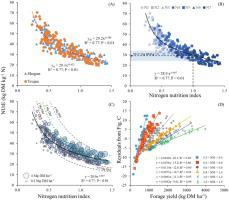Field Crops Research ( IF 5.6 ) Pub Date : 2021-03-02 , DOI: 10.1016/j.fcr.2021.108101 Patricio Sandaña , Iris A. Lobos , Paula B. Pavez , Cristian J. Moscoso

|
Improving nitrogen (N) utilization efficiency (NUtE (kg dry matter (DM) kg−1 N uptake)) is one of the challenges of modern grassland systems in order to improve nitrogen use efficiency. The NUtE is highly variable in response to climate and N supply. Therefore, NUtE must be assessed in relation to the N nutrition index (NNI) and forage yield in pastures growing under different N supplies and environments. The aim of this study was to assess NUtE and NNI in response to different ryegrass genotypes, N supplies and harvest times. Two experiments were conducted in southern Chile for this purpose. In each experiment, treatments were the factorial combination of two hybrid ryegrass cultivars (Shogun and Trojan) and seven N fertilization rates (0, 50, 100, 200, 350, 525 and 700 kg N ha−1 yr−1). A wide range in N uptake, NUtE and NNI were observed (N uptake: 4 – 134 kg N ha−1; NUtE: 20 – 71 kg DM kg−1 N uptake; NNI: 0.23 – 1.43) across experiments. The main sources of variation of the above-mentioned variables were N rates and harvest times. Across experiments, the NUtE was described by a negative power function (R2 = 0.77, P < 0.01) in relation to the NNI and the remaining variability in NUtE was well explained by the forage yield, demonstrating that NUtE depends on the N nutritional status and forage yield. A reference NUtE of 29 ± 5.1 kg DM kg−1 is proposed for grasslands growing at optimal N status (NNI = 1). Therefore, both the NNI and forage yield must be taken into account when interpreting how NUtE responds to genotypes cultivated under different N availabilities and growing conditions.
中文翻译:

氮素营养指数和饲草产量解释了不同氮素利用率下杂种黑麦草的氮素利用效率
为了提高氮利用效率,提高氮(N)利用效率(NUtE(千克干物质(DM)kg -1 N吸收))是现代草地系统面临的挑战之一。NUtE随气候和氮供应而变化很大。因此,在不同氮素供应和环境下生长的牧场中,必须根据氮素营养指数(NNI)和牧草产量来评估NUtE。这项研究的目的是评估NUtE和NNI对不同黑麦草基因型,氮供应和收获时间的反应。为此,在智利南部进行了两次实验。在每个实验中,处理方法是两个杂种黑麦草品种(Shogun和Trojan)和七个氮肥施用量(0、50、100、200、350、525和700 kg N ha - 1年)的因子组合。-1)。在整个实验中观察到了广泛的氮吸收,NUtE和NNI(氮吸收:4 – 134 kg N ha -1; NUtE:20 – 71 kg DM kg -1 N吸收; NNI:0.23 – 1.43)。上述变量变化的主要来源是氮素利用率和收获时间。在整个实验中,相对于NNI,NUtE被描述为负幂函数(R 2 = 0.77,P <0.01),而NUtE中的剩余变异性可通过饲草产量很好地解释,表明NUtE取决于N的营养状况和草料产量。参考NUtE为29±5.1 kg DM kg -1建议将其用于以最佳氮素状态(NNI = 1)生长的草地。因此,在解释NUtE对不同氮素利用率和生长条件下栽培的基因型的反应时,必须同时考虑NNI和饲草产量。











































 京公网安备 11010802027423号
京公网安备 11010802027423号